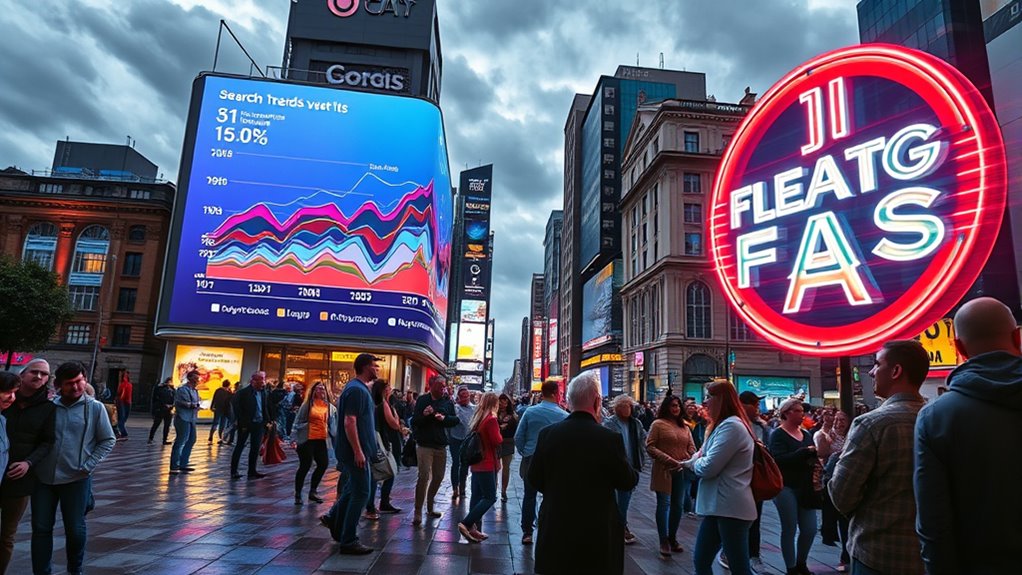Understanding the difference between search trends and fads helps you make smarter decisions. Trends develop gradually, stay relevant over months or years, and reflect deeper societal or technological shifts. Fads spike quickly, fueled by viral moments, but fade just as fast. Chasing trends ensures long-term growth, while fads can lead to wasted resources. If you want to spot which is which and forge a sustainable path, there’s more to learn below.
Key Takeaways
- Focus on sustained interest over time to identify genuine search trends, not temporary spikes typical of fads.
- Use analytics tools like Google Trends to differentiate between long-term patterns and viral fleeting moments.
- Recognize that true trends are linked to societal or technological shifts, ensuring lasting relevance.
- Be cautious of short-lived spikes driven by viral content, which may not justify long-term investments.
- Prioritize strategic decisions based on consistent, steady interest rather than chasing viral fads for quick gains.

In today’s fast-paced digital world, understanding the difference between search trends and fads can help you make smarter decisions online. When you notice a sudden spike in interest around a particular topic or product, it’s tempting to jump on the bandwagon. But not every surge in popularity is sustainable or worth investing your time and resources in. Knowing how to distinguish between a genuine search trend and a passing fad can save you from wasting effort on something that won’t stand the test of time.
Search trends are usually driven by underlying shifts in consumer behavior, societal interests, or technological advancements. They tend to develop gradually and maintain relevance over a longer period. For example, the rise of electric vehicles or renewable energy sources reflects broader changes in societal values and policy. These trends often have staying power because they’re tied to fundamental shifts in how people live, work, or think. When you tap into a real trend, you’re aligning yourself with long-term interests, making your efforts more sustainable and impactful.
Fads, on the other hand, are characterized by their rapid rise and quick decline. They’re often fueled by viral moments, celebrity endorsements, or fleeting cultural phenomena. Think of viral dances, limited-edition products, or meme-based challenges. Fads are attractive because they seem to explode overnight, attracting lots of attention fast. However, that attention usually fizzles out just as quickly. Investing heavily in a fad can be risky because it might not generate lasting value or engagement once the hype dies down. If you’re looking to build a solid reputation or a sustainable business, chasing fads can lead to wasted resources and missed opportunities for more meaningful growth.
To avoid chasing the wrong curve, you need to stay critical and analytical. Look beyond the surface of what’s trending and ask yourself whether it aligns with larger patterns or just temporary hype. Use tools like Google Trends, social media analytics, and industry reports to gauge the longevity and depth of a particular phenomenon. If interest in a topic remains steady over months and across different audiences, then it’s likely a true trend worth following. Conversely, if the spike is isolated to a specific event, meme, or short-lived campaign, it’s probably a fad. Additionally, understanding the Gold IRA market and how investors approach diversification can help you assess whether certain trends are sustainable and aligned with long-term financial goals.
Ultimately, your goal should be to focus on trends that have the potential for lasting impact. Fads can be fun and exciting, but they often lead to short-term gains at best. By understanding the difference, you’ll be better equipped to make informed decisions, invest wisely, and build a presence that endures beyond the latest viral moment. Recognizing the difference between a search trend and a fad isn’t just about avoiding mistakes—it’s about positioning yourself for sustained success in an ever-changing digital landscape.
Frequently Asked Questions
How Can I Identify Lasting Search Trends Early?
You can identify lasting search trends early by monitoring consistent increases in search volume over time, rather than short spikes. Use tools like Google Trends, analyze related keywords, and follow industry news and social media buzz. Pay attention to how the conversation evolves—if it sustains momentum and attracts diverse audiences, it’s likely a lasting trend. Stay adaptable and keep tracking data to spot these signals before they become mainstream.
What Are Common Signs of a Passing Fad?
You’ll notice a passing fad often has a quick spike in popularity followed by a rapid decline, with little sustained interest. It may also lack deeper conversations or integrations into daily life. If social media buzz fades fast and mainstream adoption remains limited, it’s likely just a fleeting trend. Avoid investing too much time or resources; instead, focus on signals of longevity, like consistent engagement and broader cultural relevance.
Do Search Trends Predict Long-Term Market Success?
Do search trends predict long-term market success? Not always. While rising search interest can signal genuine demand, it’s no guarantee of sustained growth. You need to look beyond fleeting spikes and ask whether the trend addresses a real problem or just a temporary buzz. Long-term success depends on consistent value and adaptability, not just short-term popularity. Keep an eye on the bigger picture, not just the latest search spike.
How Do Cultural Factors Influence Search Trend Longevity?
Cultural factors heavily influence how long search trends last. If a trend aligns with your audience’s values, traditions, or societal norms, it’s more likely to stick around. You should pay attention to cultural signals, such as language, holidays, or social movements, to gauge longevity. When you incorporate these insights, you’re better equipped to distinguish genuine trends from fleeting fads, ensuring your efforts are sustainable over time.
Can Social Media Accelerate the Rise and Fall of Trends?
Yes, social media accelerates the rise and fall of trends. When you share or engage with content, algorithms amplify its reach quickly, making trends skyrocket in popularity. But this rapid spread also means trends fade faster as users move on to the next big thing. Your quick sharing habits can therefore influence how long a trend lasts, often shortening its lifespan while boosting its initial popularity.
Conclusion
Remember, chasing every passing wave can lead you off course. Instead, stay anchored to genuine search trends that gently guide your journey. Fads may sparkle briefly, but true insight offers a steady, calming current. Trust in the subtle currents of lasting interest—they’ll carry you further than fleeting excitement ever could. By choosing the right wave to ride, you’ll find yourself gliding smoothly toward meaningful growth, all while avoiding the rocky shoals of empty trends.









